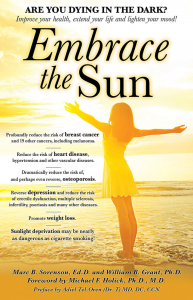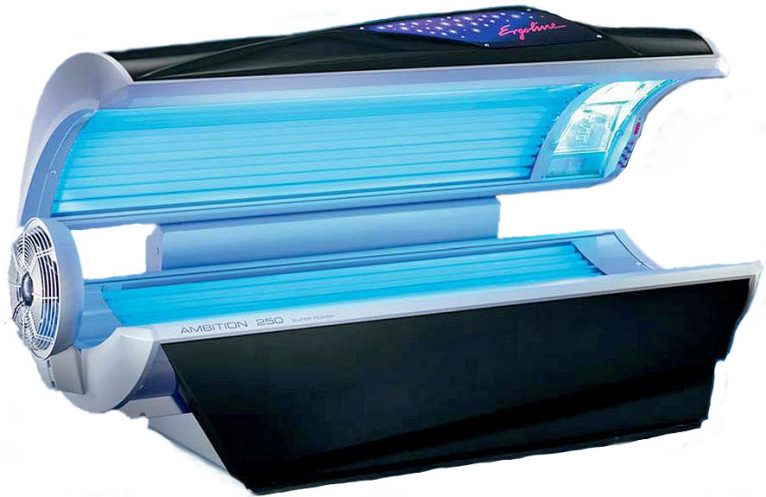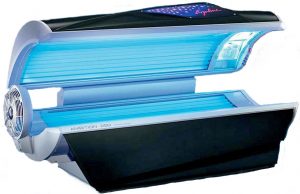UV index. Vita min D and health. By Marc Sorenson, EdD
min D and health. By Marc Sorenson, EdD
The UV index is a measure of the intensity of ultraviolet radiation B (UVB) from the sun. It is expressed as a number on a scale of 0-11. A higher number indicates a higher sunlight intensity. Exposure to the ultraviolet B (UVB) portion of sunlight is necessary to cause the skin to produce vitamin D. Nevertheless, unless the body is deeply tanned or naturally very dark, a very high UV index can cause sunburn, so caution is necessary.
A low UV index is also problematic.
However, if the UV index is very low, it cannot stimulate the production of vitamin D in the skin. Vitamin D production is essential for human health. Thus, lack of vitamin D may be a major reason that flu-like diseases occur primarily during winter, when there is little or no vitamin D production. This, of course varies according to latitude.
A List of vitamin D benefits from Business Insider.
A recent article from Business Insider (a Philippines online paper) discussed various health effects of vitamin D and sun exposure. Here are some of their salient points, not all of which are correct.
- The primary cause of vitamin D deficiency is sun deprivation (correct).
- Vitamin D helps keep the immune system, so deficiency could be the reason for frequent flu (correct).
- You can get more vitamin D by spending at least 5 to 10 minutes outside 3 times a week without sunscreen (correct).
How much vitamin D does a person need?
- The most incorrect statement of the article is this. The average adult needs around 600 international units (IU) of vitamin D a day (not correct). For reference, a serving of salmon contains roughly 400 IU (not correct). 20 minutes of full-body, unobstructed sunlight can cause the skin to produce up to 20,000 IU of vitamin D. If 600 IU were the only source of vitamin D, one would produce a level of six ng/ml, which would be woefully inadequate. 600 IU is only slightly better than nothing.
- Fifteen minutes of non-burning midday sun (without sunscreen) would optimize vitamin D levels in a few days. Dark-skinned individuals would need much more exposure, up to an hour.
-
Getting more frequent colds or respiratory infections could be a symptom of vitamin D deficiency (correct). However, it is even more likely to be a sign of sunlight deprivation.
- Colds and flu nearly disappear in the summer when the sun is direct. During this time of the coronavirus epidemic, everyone on earth needs daily direct or indirect sun exposure. Those who do not tan can obtain plenty of sunlight from being outdoors under an umbrella or even in the shade near where the sun is shining.
-
Bone diseases, vitamin D and sunlight.
- Vitamin D deficiency can cause Osteomalacia and Osteoporosis, conditions where your bones become less dense (correct). Sun exposure produces about 90% of the body’s serum levels of vitamin D. In addition, not all vitamin D supplement studies have produced stronger bones.
Sunlight is king for increasing bone strength.
- However, sun exposure, or exposure to sunbeds (tanning beds) produces marvelous results. For example, a Spanish study showed that women in Spain—those who regularly enjoyed sun exposure—had about one-eleventh the risk of hip fractures as women who had little exposure. Women who use sunbeds also have profoundly higher bone mass than women who do not use them. Their vitamin D levels are also remarkably higher.
-
Mental problems due to a low UV index and subsequent vitamin D deficiency.
- Vitamin D has some links to depression (correct). Nevertheless, that link in my opinion is 100% due to to sun deprivation. Dr. Gavin Lambert and his colleagues in Australia measured serotonin levels in response to varying degrees of bright light. To do so, they drew blood samples from the internal jugular veins of 101 men and compared the serotonin concentrations of the blood to weather conditions and seasons. The results were remarkable: Men measured on a very bright day produced eight times more serotonin than those measured on a cloudy, dismal day.
More on the UV index and “solar noon.”
When meteorologists report UV index, the emphasis usually warns against the maximum UV level. That level generally occurs around “solar noon.” Solar noon is a four-hour period stretching from 10:00 AM to 2:00 PM. As you have probably noticed, forecasters constantly warn us to avoid the 10:00 to 2:00 hours. Avoiding intense UV radiation is their watchword. Many of them say, “Get sun exposure in the early morning or late afternoon to produce vitamin D.” They should know that the UV index must be over 3 to produce vitamin D.
These reporters do not understand how low UV index hinders vitamin D production.
They do not comprehend that UV index is so weak in the morning that it produces absolutely no vitamin D. The same is true in the evening. Therefore, the closer to solar noon you plan your outdoor time, the more vitamin D you will produce. Vitamin D produced in the skin from solar UVB exposure does not lead to vitamin D toxicity and is safe, as the body limits its own production.
Another method to measure the efficacy of sunlight for vitamin D is to stand in the sun at any time of day and observe your shadow. If your shadow is shorter than your height, you are producing vitamin D. This, the shorter the shadow, better.
Caveats regarding the UV index and vitamin D. Morning sun is still very healthful.
Early morning sun exposure, when the UV index is very low, (under 3) has remarkable health effects. These include resetting the circadian rhythm, increasing production of serotonin, lowering blood pressure through nitric-oxide production and assisting weight loss. Nevertheless, vitamin D stimulation in the skin is not one of the health effects of early morning light.
So safely soak up the sun at any time of day and reap the health benefits. Never burn.
Happy sunning!
For more information: http://sunlightinstitute.org/ and read the book, Embrace the Su n.
n. 
Sunbeds can be healthful devices. By Marc Sorenson, EdD.

Sunbeds, also known as tanning beds, have many healthful properties. They produce vitamin D, strengthen bone and reduce the risk of major cancers. Yet, sunbeds are much maligned as being a major cause of melanoma. Thus, teens in many areas have been banned from using them by misguided legislation. In addition, tanning- salon owners must live in fear of government overreach that could put them out of business.
But new research shows that the attack on sunbeds is misguided.
Because of this uproar, a group of scientists (some dermatologists), led by Dr. Jörg Reichrath, did a thorough research review. Furthermore, they published their findings in the scientific journal Anticancer Research, which presented truth about melanoma and sunbeds. This information is most noteworthy since it is contrary to the prevailing papers that emanate from the Powers of Darkness. The Powers of Darkness are those who love to attack both sun exposure and sunbeds.
Especially relevant points regarding sunbeds and melanoma risk, from Anticancer Research:
- First of all, Reichrath and colleagues performed a systematic literature search. This research was undertaken to identify and evaluate research that investigated relationship of solarium use (sunbed use) and melanoma risk. And as a result, they stated the following: “We found no studies that demonstrate a causal relationship between moderate solarium use and melanoma risk.” In addition, they indicated that the quality of the observational studies was low and that bias may have existed.
- Another interesting finding was that although moderate sunbed use had no effect on melanoma, something else did affect melanoma. An unhealthy lifestyle involving extensive sunbathing, alcohol and smoking associated to a 20% increase in the disease. Also, the researchers mention that individuals with unhealthful lifestyles use tanning salons more often.
At this time, I must make a point. Those who are regularly in the sun have stronger bones and less cancer than sun avoiders. So I’m not sure what “extensive” sunbathing entailed. And, another point is this: As time spent in the sun has decreased profoundly in both Europe and the U.S., melanoma has increased exponentially. Read my book, Embrace the Sun, to see the discussion on this topic.
Could sunbeds actually decrease the risk of melanoma?
Another salient finding of the research review: A study from Europe showed that sunbed use was associated with a 30% reduced risk for developing melanoma. Reichrath and colleagues made this comment on that study: “Those findings indicate that solarium [sunbed] use may even have a protective effect.”
Sunbeds: beyond melanoma. Here are a few truths about sunbeds that are seldom discussed:
The transcendent sunbed study showed that during 20-years, women who used them reduced all-cause mortality by 23%. So let’s suppose that that there were some health problems with using sunbeds. That negative possibility pales in comparison to the remarkably reduced risk of death, does it not? And, I am not stating that there were negatives for sunbed use in this research.
What are some of the reasons that sunbed use is associated with a lower risk of all cause death?
Another investigation showed that sunbeds were associated with a reduced the risk of breast cancer.
In addition, research showed that sunbeds were associated with 90% higher vitamin D levels and significantly stronger bones.
Also, they are useful in treating psoriasis and other skin disorders.
Sunbeds are also useful in treating pain and in improving mood.
Finally, these devices have been shown to associate with lower clot risk.
The takeaway from all of these studies is that there is no credible research that melanoma is increased by using sunbeds. And, sunbeds have remarkably healthful effects. When receiving sun exposure or using sunbeds, be sure not to burn.
Happy sunning!
For more information, read the book, Embrace the Sun.
 Do sunbeds have healthful effects?The Vitamin D Society of Canada recently issued a significant news release: It describes new research reported on the vitamin D-producing effects of tanning salon sunbeds. The study was published in the journal DermatoEndocrinology,[1] and it found that standard tanning salon sunbeds are very effective in raising serum levels of vitamin D. Those who used the beds were able to attain optimal levels (more than 100 nmol/L) [40ngml] D during winter. Actually, another earlier study had also showed similar results,[2] so this research served to corroborate that finding.
Do sunbeds have healthful effects?The Vitamin D Society of Canada recently issued a significant news release: It describes new research reported on the vitamin D-producing effects of tanning salon sunbeds. The study was published in the journal DermatoEndocrinology,[1] and it found that standard tanning salon sunbeds are very effective in raising serum levels of vitamin D. Those who used the beds were able to attain optimal levels (more than 100 nmol/L) [40ngml] D during winter. Actually, another earlier study had also showed similar results,[2] so this research served to corroborate that finding.
The significance of this evidence about sunbeds cannot be overemphasized.
This is transcendentally important information for Canadians! They receive little or no vitamin D-producing sun exposure in winter. It is similarly important for all others who live at high latitudes, work indoors or are rarely exposed to sunlight. Vitamin D deficiency, primarily due to lack of sun exposure, is a disaster that becomes larger each year. The reason? The Powers of Darkness continue to promote sun avoidance and sunscreen use. It has been shown that an SPF 15 sunscreen will decrease sun-stimulated vitamin D production by up to 99.5%.[3]
The paper was written by Doctors Samantha Kimball, Jasmine Lee and Reinhold Vieth. Here is the research link: http://www.tandfonline.com/doi/full/10.1080/19381980.2017.1375635
This new research builds on the importance of vitamin D health benefits: It found that if Canadians raised their vitamin D blood levels to an optimal 100 nmol/L, it could prevent 23,000 premature deaths. It could also save $12.5 Billion annually in direct health care costs. The researchers indicate that low vitamin D levels in winter leave one more susceptible to many diseases. Some of these include colds and flu. And, they also lead to more serious illnesses such as osteoporosis, diabetes, multiple sclerosis, many cancers and heart disease. Remember this, however: The sunbeds that emit Ultraviolet B (UVB) light are the only ones that should be used. UVB is necessary for the production of vitamin D. The high pressure beds produce little or no UVB. Therefore, I do not recommend them.
Due to the scare tactics of those who frighten the public out of the sunlight, many other facts about the beneficial effects of sunbeds have been forgotten or hidden. Below are a few more of those facts.
Healthful Effects of Sunbeds:
- Sunbeds strengthen bone. As mentioned above, one study compared 50 subjects who used a sunbed at least once weekly, to 106 control subjects who did not use them. Sunbed users had 90% higher vitamin D levels than non-users. They also had significantly higher bone-mineral density, indicative of stronger bones.[4]
- Sunbeds can control psoriasis and eczema. Research showed convincingly that sunbeds are a valid treatment for psoriasis.[5] And, it also stated another conclusion: Sunbeds could be useful “as a treatment option for atopic dermatitis [eczema], mycosis fungoides, acne, scleroderma, vitiligo, and pruritus, as well as other UV sensitive dermatoses.”
- Sunbeds use reduce chronic pain.[6], [7] A study of pain in fibromyalgia patients, conducted by dermatologists, revealed that those who used UV-producing sunbeds experienced a decrease of 0.44 points on a 10 point scale (Likert scale), when compared to those who did not receive UV light. Furthermore, feelings of well-being and relaxation were also reported among the tanners.
- Sunbeds may help unborn children. Sunbeds are now being recommended for use by pregnant women who will give birth in a winter month, in order to protect the unborn child from osteoporosis during adulthood.[8]
- Sunbed use reduces the risk of clots. In an eleven-year study of the sun-exposure habits of 40,000 women, venous thrombotic (clotting) events were measured. It was found that women who sunbathed during the summer, on winter vacations, or when abroad, or used sunbeds, were at 30% reduced risk of clots compared to those who did not sunbathe.[9]
-
Sunbed use is associated with lower breast-cancer risk.[10]
- Sunbed use reduces the risk of death. Finally, Perhaps the most important research on sunbeds was a 20-year study: it showed that women who used sunbeds were 23% less likely to die from any cause than women who did not use them. [11]
Due to the health benefits, and also due to the way they help my mood, I enjoy using sunbeds. Nevertheless, I am not telling you to use them or to avoid them. However, the aforementioned positive information should at least help you to make an informed decision. Stay healthy and remember that the sun is your friend!
[1] Samantha Kimball, Jasmine Lee and Reinhold Vieth. Sunbeds with UVB radiation can produce physiological levels of serum 25-Hydroxyvitamin D in healthy volunteers. Article: e1375635. Published online: 06 Oct 2017.
[2] Tangpricha V, Turner A, Spina C, Decastro S, Chen TC, Holick MF. Tanning is associated with optimal vitamin D status (serum 25-hydroxyvitamin D concentration) and higher bone mineral density. Am J Clin Nutr 2004;80:1645-49.
[3] Matsuoka LY, Ide L, Wortsman J, MacLaughlin JA, Holick MF. Sunscreens suppress cutaneous vitamin D3 synthesis. .Journal of Clinical Endocrinology & Metabolism 1987; 64:1165-68.
[4] Tangpricha V, Turner A, Spina C, Decastro S, Chen TC, Holick MF. Tanning is associated with optimal vitamin D status (serum 25-hydroxyvitamin D concentration) and higher bone mineral density. Am J Clin Nutr 2004;80:1645-49.
[5] Radack KP, Farhangian ME, Anderson KL, Feldman SR. A review of the use of tanning beds as a dermatological treatment. Dermatol Ther (Heidelb). 2015 Mar;5(1):37-51.
[6] Kaur M, Feldman SR, Liguori A, Fleischer AB Jr. Indoor tanning relieves pain. Photodermatol Photoimmunol Photomed. 2005 Oct;21(5):278.
[7] Taylor SL, Kaur M, LoSicco K, Willard J, Camacho F, O’Rourke KS, Feldman SR. Pilot study of the effect of ultraviolet light on pain and mood in fibromyalgia syndrome. J Altern Complement Med. 2009 Jan;15(1):15-23.
[8] Bukhari, M. Quoted in London Times April 27, 2008.
[9] Lindqvist PG, Epstein E, Olsson H. Does an active sun exposure habit lower the risk of venous thrombotic events? A D-lightful hypothesis. J Thromb Haemost. 2009 Apr;7(4):605-10.
[10] Yang L, Veierød MB, Löf M, Sandin S, Adami HO, Weiderpass E. Prospective study of UV exposure and cancer incidence among Swedish women. J Intern Med. 2014 Jul;276(1):77-86
[11] Lindqvist PG, Epstein E, Landin-Olsson M, Ingvar C, Nielsen K, Stenbeck M, Olsson H. Avoidance of sun exposure is a risk factor for all-cause mortality: results from the Melanoma in Southern Sweden cohort. J Intern Med. 2014 Jul;276(1):77-86.
Teen tanning by Marc Sorenson, EdD….
“There are lies, damn lies and statistics,” or so the saying goes. Karen Selick, of the Canadian Constitution Foundation, some time ago penned a press release entitled: Don’t outlaw teen tanning.[1] I was fortunate that a friend thought I’d be interested. He sent me the release, even though the release was published in 2013.
Selick’s discussion gives an excellent explanation of how the twisting of statistics may lead to a total misinterpretation of the truth. She discusses the fact that anti-tanning advocates consistently state that using indoor tanning equipment before the age of 35 results in a 75% increase in the risk of developing melanoma. That does sound frightening, but when the figures are looked at more closely, she explains that the actual risk of young people contracting melanoma is almost negligible.
Her reasoning is brilliant. She consulted the Statistics Canada Causes of Death database, and demonstrates that in the decade from 2000 to 2009, the last decade from which statistics for teens were available, 5 Canadians 19 years of age or younger died from melanoma. In other words about a half-person per year.
She also points out that among teens during that same decade, there were 195 deaths from falls, 627 deaths from drowning and 6,972 from “transport accidents.”
To draw an analogy, Ms. Selick states the following: “……….. suppose that only one person in Canada were to be murdered in 2014. If two people were murdered in 2015, that would constitute a shocking 100 percent increase in the murder rate — but it would still be only two people, an extraordinarily low murder rate for a country of 34 million people.”
Another observation from the press release was a comparison of the risk of heart disease in Scotland, where sunlight is scarce, with Australia, where sunlight is abundant. The Australians have a one-third reduced risk of death rates from heart attacks. Ms. Selick’s release states that “Those who would ban teen tanning focus so intently on skin cancer that they seem completely oblivious to the health benefits that sun exposure (real or simulated) can confer.”
I have mentioned in this blog that there are 324 lives lost from diseases that are associated with sun deficiency for every life lost to diseases associated with sun exposure, and since sunbeds produce the same type of light as sun exposure, it is not surprising that sunbeds have healthful effects.
We also now have research that demonstrates that over 20 years, women who use sunbeds have a 23% reduced risk of all-cause death.[2]
Dr. Richard Weller, a dermatologist and the author of many pro-sun research studies, often discusses the beneficial effect of nitric oxide, a photoproduct of sun and sunbed exposure. He makes a compelling case that nitric oxide dramatically reduces the risk of hypertension and heart disease. Here is one of his statements:
“The prevalence of cardiovascular and cerebrovascular deaths is around 100 times higher than those from skin cancer. Interventions leading to small changes in the incidence of cardiovascular disease are thus of greater benefit to the health of the public even than large changes in skin-cancer incidence.”[3]
I am not here to suggest that you use a sunbed. That is up to you. I have my own sunbed and enjoy it without the least worry. Just be sure that when you use a sunbed or engage in sunbathing, do it safely without burning.
[1] http://www.huffingtonpost.ca/karen-selick/skin-cancer-tanning-beds_b_2744788.html
[2] Lindqvist PG, Epstein E, Landin-Olsson M, Ingvar C, Nielsen K, Stenbeck M, Olsson H. Avoidance of sun exposure is a risk factor for all-cause mortality: results from the Melanoma in Southern Sweden cohort. J Intern Med. 2014 Jul;276(1):77-86.
[3] Weller R. The health benefits of UV radiation exposure through vitamin D production or non-vitamin D
Pathways. Blood pressure and cardiovascular disease. Photochem. Photobiol. Sci. 2016, DOI: 10.1039/C6PP00336B.

